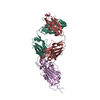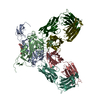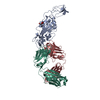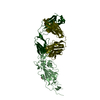[English] 日本語
 Yorodumi
Yorodumi- PDB-8e1g: SARS-CoV-2 RBD in complex with Omicron-neutralizing antibody 2A10 -
+ Open data
Open data
- Basic information
Basic information
| Entry | Database: PDB / ID: 8e1g | ||||||
|---|---|---|---|---|---|---|---|
| Title | SARS-CoV-2 RBD in complex with Omicron-neutralizing antibody 2A10 | ||||||
 Components Components |
| ||||||
 Keywords Keywords | VIRAL PROTEIN / SARS-CoV-2 / Omicron / antibody / neutralizing | ||||||
| Function / homology |  Function and homology information Function and homology informationMaturation of spike protein / viral translation / Translation of Structural Proteins / Virion Assembly and Release / host cell surface / host extracellular space / suppression by virus of host tetherin activity / Induction of Cell-Cell Fusion / structural constituent of virion / host cell endoplasmic reticulum-Golgi intermediate compartment membrane ...Maturation of spike protein / viral translation / Translation of Structural Proteins / Virion Assembly and Release / host cell surface / host extracellular space / suppression by virus of host tetherin activity / Induction of Cell-Cell Fusion / structural constituent of virion / host cell endoplasmic reticulum-Golgi intermediate compartment membrane / entry receptor-mediated virion attachment to host cell / receptor-mediated endocytosis of virus by host cell / Attachment and Entry / membrane fusion / positive regulation of viral entry into host cell / receptor-mediated virion attachment to host cell / receptor ligand activity / host cell surface receptor binding / fusion of virus membrane with host plasma membrane / fusion of virus membrane with host endosome membrane / viral envelope / virion attachment to host cell / SARS-CoV-2 activates/modulates innate and adaptive immune responses / host cell plasma membrane / virion membrane / identical protein binding / membrane / plasma membrane Similarity search - Function | ||||||
| Biological species |  Homo sapiens (human) Homo sapiens (human) | ||||||
| Method |  X-RAY DIFFRACTION / X-RAY DIFFRACTION /  SYNCHROTRON / SYNCHROTRON /  MOLECULAR REPLACEMENT / Resolution: 2.57 Å MOLECULAR REPLACEMENT / Resolution: 2.57 Å | ||||||
 Authors Authors | Wasserman, H. / Hastie, K.M. / Buck, T.K. / Saphire, E.O. | ||||||
| Funding support | 1items
| ||||||
 Citation Citation |  Journal: Cell Rep / Year: 2023 Journal: Cell Rep / Year: 2023Title: Potent Omicron-neutralizing antibodies isolated from a patient vaccinated 6 months before Omicron emergence. Authors: Kathryn M Hastie / Xiaoying Yu / Fernanda Ana-Sosa-Batiz / Dawid S Zyla / Stephanie S Harkins / Chitra Hariharan / Hal Wasserman / Michelle A Zandonatti / Robyn Miller / Erin Maule / Kenneth ...Authors: Kathryn M Hastie / Xiaoying Yu / Fernanda Ana-Sosa-Batiz / Dawid S Zyla / Stephanie S Harkins / Chitra Hariharan / Hal Wasserman / Michelle A Zandonatti / Robyn Miller / Erin Maule / Kenneth Kim / Kristen M Valentine / Sujan Shresta / Erica Ollmann Saphire /  Abstract: Therapeutic antibodies are an important tool in the arsenal against coronavirus infection. However, most antibodies developed early in the pandemic have lost most or all efficacy against newly ...Therapeutic antibodies are an important tool in the arsenal against coronavirus infection. However, most antibodies developed early in the pandemic have lost most or all efficacy against newly emergent strains of severe acute respiratory syndrome coronavirus 2 (SARS-CoV-2), particularly those of the Omicron lineage. Here, we report the identification of a panel of vaccinee-derived antibodies that have broad-spectrum neutralization activity. Structural and biochemical characterization of the three broadest-spectrum antibodies reveal complementary footprints and differing requirements for avidity to overcome variant-associated mutations in their binding footprints. In the K18 mouse model of infection, these three antibodies exhibit protective efficacy against BA.1 and BA.2 infection. This study highlights the resilience and vulnerabilities of SARS-CoV-2 antibodies and provides road maps for further development of broad-spectrum therapeutics. | ||||||
| History |
|
- Structure visualization
Structure visualization
| Structure viewer | Molecule:  Molmil Molmil Jmol/JSmol Jmol/JSmol |
|---|
- Downloads & links
Downloads & links
- Download
Download
| PDBx/mmCIF format |  8e1g.cif.gz 8e1g.cif.gz | 323.9 KB | Display |  PDBx/mmCIF format PDBx/mmCIF format |
|---|---|---|---|---|
| PDB format |  pdb8e1g.ent.gz pdb8e1g.ent.gz | 209.5 KB | Display |  PDB format PDB format |
| PDBx/mmJSON format |  8e1g.json.gz 8e1g.json.gz | Tree view |  PDBx/mmJSON format PDBx/mmJSON format | |
| Others |  Other downloads Other downloads |
-Validation report
| Summary document |  8e1g_validation.pdf.gz 8e1g_validation.pdf.gz | 491.1 KB | Display |  wwPDB validaton report wwPDB validaton report |
|---|---|---|---|---|
| Full document |  8e1g_full_validation.pdf.gz 8e1g_full_validation.pdf.gz | 505.3 KB | Display | |
| Data in XML |  8e1g_validation.xml.gz 8e1g_validation.xml.gz | 43.8 KB | Display | |
| Data in CIF |  8e1g_validation.cif.gz 8e1g_validation.cif.gz | 60.7 KB | Display | |
| Arichive directory |  https://data.pdbj.org/pub/pdb/validation_reports/e1/8e1g https://data.pdbj.org/pub/pdb/validation_reports/e1/8e1g ftp://data.pdbj.org/pub/pdb/validation_reports/e1/8e1g ftp://data.pdbj.org/pub/pdb/validation_reports/e1/8e1g | HTTPS FTP |
-Related structure data
| Related structure data |  8f0gC  8f0hC  6xe1S S: Starting model for refinement C: citing same article ( |
|---|---|
| Similar structure data | Similarity search - Function & homology  F&H Search F&H Search |
- Links
Links
- Assembly
Assembly
| Deposited unit | 
| ||||||||||||
|---|---|---|---|---|---|---|---|---|---|---|---|---|---|
| 1 | 
| ||||||||||||
| 2 | 
| ||||||||||||
| Unit cell |
|
- Components
Components
| #1: Antibody | Mass: 24003.928 Da / Num. of mol.: 2 Source method: isolated from a genetically manipulated source Source: (gene. exp.)  Homo sapiens (human) / Cell line (production host): ExpiCHO / Production host: Homo sapiens (human) / Cell line (production host): ExpiCHO / Production host:  #2: Antibody | Mass: 23421.912 Da / Num. of mol.: 2 Source method: isolated from a genetically manipulated source Source: (gene. exp.)  Homo sapiens (human) / Cell line (production host): ExpiCHO / Production host: Homo sapiens (human) / Cell line (production host): ExpiCHO / Production host:  #3: Protein | Mass: 31525.307 Da / Num. of mol.: 2 Source method: isolated from a genetically manipulated source Source: (gene. exp.)  Gene: S, 2 / Cell line (production host): ExpiCHO / Production host:  #4: Sugar | Has ligand of interest | N | |
|---|
-Experimental details
-Experiment
| Experiment | Method:  X-RAY DIFFRACTION / Number of used crystals: 1 X-RAY DIFFRACTION / Number of used crystals: 1 |
|---|
- Sample preparation
Sample preparation
| Crystal | Density Matthews: 2.89 Å3/Da / Density % sol: 57.41 % |
|---|---|
| Crystal grow | Temperature: 293 K / Method: vapor diffusion, hanging drop Details: 1 uL 7.4 mg/mL protein; 1 uL 23%w/v PEG 3350, 230 mM Ammonium fluoride |
-Data collection
| Diffraction | Mean temperature: 100 K / Serial crystal experiment: N |
|---|---|
| Diffraction source | Source:  SYNCHROTRON / Site: SYNCHROTRON / Site:  APS APS  / Beamline: 31-ID / Wavelength: 0.9793 Å / Beamline: 31-ID / Wavelength: 0.9793 Å |
| Detector | Type: DECTRIS PILATUS3 S 6M / Detector: PIXEL / Date: Jul 16, 2022 |
| Radiation | Monochromator: CRYSTAL SI(111) / Protocol: SINGLE WAVELENGTH / Monochromatic (M) / Laue (L): M / Scattering type: x-ray |
| Radiation wavelength | Wavelength: 0.9793 Å / Relative weight: 1 |
| Reflection | Resolution: 2.57→92.79 Å / Num. obs: 58806 / % possible obs: 99.4 % / Redundancy: 6.7 % / Biso Wilson estimate: 56.33 Å2 / CC1/2: 0.999 / Rmerge(I) obs: 0.08 / Net I/σ(I): 16.1 |
| Reflection shell | Resolution: 2.57→2.61 Å / Redundancy: 7.1 % / Rmerge(I) obs: 0.918 / Mean I/σ(I) obs: 2.1 / Num. unique obs: 2888 / CC1/2: 0.789 / % possible all: 99.6 |
- Processing
Processing
| Software |
| |||||||||||||||||||||||||||||||||||||||||||||||||||||||||||||||||||||||||||||||||||||||||||||||||||||||||||||||||||||||||||||||||||||||||||||||||||
|---|---|---|---|---|---|---|---|---|---|---|---|---|---|---|---|---|---|---|---|---|---|---|---|---|---|---|---|---|---|---|---|---|---|---|---|---|---|---|---|---|---|---|---|---|---|---|---|---|---|---|---|---|---|---|---|---|---|---|---|---|---|---|---|---|---|---|---|---|---|---|---|---|---|---|---|---|---|---|---|---|---|---|---|---|---|---|---|---|---|---|---|---|---|---|---|---|---|---|---|---|---|---|---|---|---|---|---|---|---|---|---|---|---|---|---|---|---|---|---|---|---|---|---|---|---|---|---|---|---|---|---|---|---|---|---|---|---|---|---|---|---|---|---|---|---|---|---|---|
| Refinement | Method to determine structure:  MOLECULAR REPLACEMENT MOLECULAR REPLACEMENTStarting model: 6XE1 Resolution: 2.57→9.99 Å / SU ML: 0.3547 / Cross valid method: FREE R-VALUE / σ(F): 1.35 / Phase error: 28.7932 Stereochemistry target values: GeoStd + Monomer Library + CDL v1.2
| |||||||||||||||||||||||||||||||||||||||||||||||||||||||||||||||||||||||||||||||||||||||||||||||||||||||||||||||||||||||||||||||||||||||||||||||||||
| Solvent computation | Shrinkage radii: 0.9 Å / VDW probe radii: 1.1 Å / Solvent model: FLAT BULK SOLVENT MODEL | |||||||||||||||||||||||||||||||||||||||||||||||||||||||||||||||||||||||||||||||||||||||||||||||||||||||||||||||||||||||||||||||||||||||||||||||||||
| Displacement parameters | Biso mean: 62.62 Å2 | |||||||||||||||||||||||||||||||||||||||||||||||||||||||||||||||||||||||||||||||||||||||||||||||||||||||||||||||||||||||||||||||||||||||||||||||||||
| Refinement step | Cycle: LAST / Resolution: 2.57→9.99 Å
| |||||||||||||||||||||||||||||||||||||||||||||||||||||||||||||||||||||||||||||||||||||||||||||||||||||||||||||||||||||||||||||||||||||||||||||||||||
| Refine LS restraints |
| |||||||||||||||||||||||||||||||||||||||||||||||||||||||||||||||||||||||||||||||||||||||||||||||||||||||||||||||||||||||||||||||||||||||||||||||||||
| LS refinement shell |
|
 Movie
Movie Controller
Controller












 PDBj
PDBj






